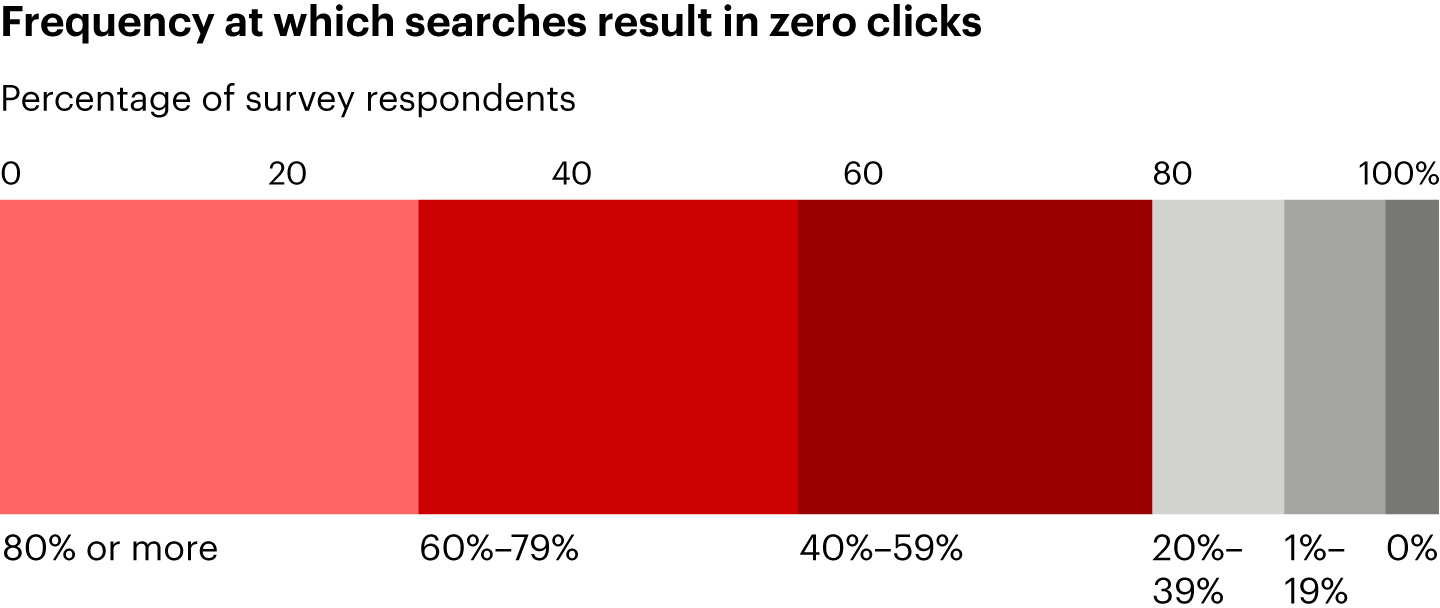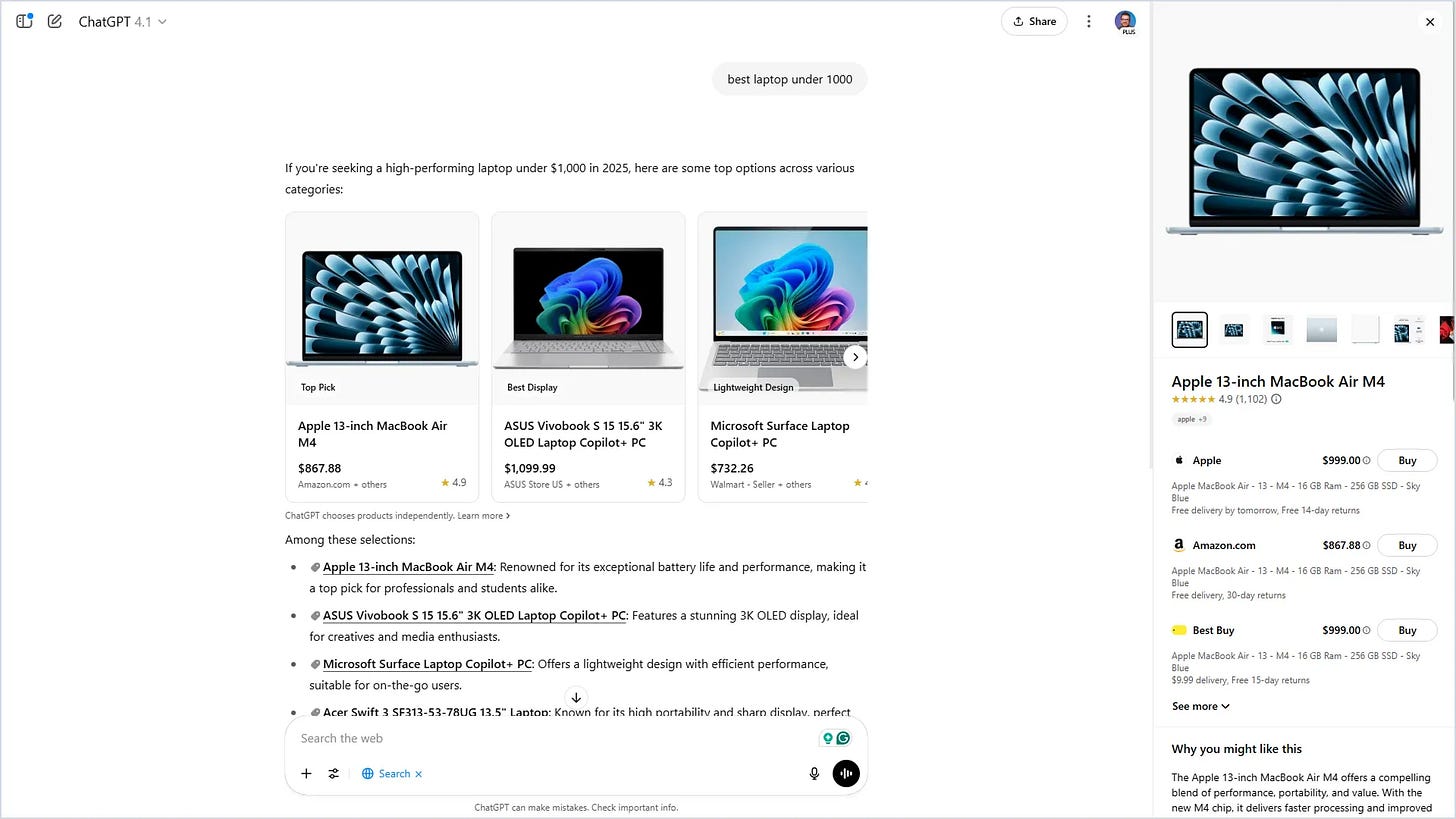Move over SEO: the rise of generative engine optimisation
Issue 124 l Eka’s Weekly Roundup (3 June 2025)
The world of search is changing. Generative AI searches (GPT, Perplexity) have grown >80% year over year. While these are still small in the overall search context, about 3% of total search volumes, they are already leading to changes in customer funnel & discovery for brands.
One example is AI Overviews, which lead to lower click through rates (up to 60% lower than pre AI summaries) but result in higher overall searches (up to 6x higher). Bain Research found that 80% of consumers rely on ‘zero click’ results at least 40% of the time. We’ve been deep in SEO Reddit threads and many marketers & brands are already commenting on how they’ve seen their performance change since the AI browser wars began.
We’re tracking two battlegrounds in these new search wars: (1) UX/UI in search, and (2) the changing customer acquisition funnel. Let’s dive in!
The sea change in search - it’s already here 🗞️
The world of search is changing. As Casey from Platformer wrote:
… two forces are coming together to inspire a potential third browser war. The first is that Chrome is under direct assault from the US government, which is currently trying to force Google to divest it as a remedy to the company's search monopoly… the second force, of course, is AI. And just as the rise of ChatGPT highlighted users' dissatisfaction with web search as it existed before 2022, these new browsers may reveal that Chrome no longer effectively serves them, either.
We are seeing behavioural shifts in browsing behaviour, from lower click through rates & consumer demand for better brand interactions.
AI-powered search is leading to more searches: this could be as high as 6x more searches per day. But the click-through rate is considerably lower than in a pre Generative Search world, up to 60% lower. Generative search will likely lead to a shift in web traffic, impacting organic site traffic by 18-64%.
For now, Google Search is still the dominant player. In 2024, it handled 5 trillion searches (14b per day), and remains 373x bigger than ChatGPT search. Google’s Search market share remains incredibly strong at 90%+, and this hasn’t (yet) shifted from pre-AI times. ChatBots are ‘only’ <3% of search traffic.
Incumbents are rolling out AI-enhanced search. Google’s AI summary features are still early, but are reportedly being serviced to 1.5b monthly users (as of May ‘25). This is the number of people who have seen AI Overviews in their results, and that the overwhelming majority engage with the bar in a meaningful way. They also said that users who engage with it end up ‘searching more often’, or about 10% increased search engine usage.
The changing landscape has a few consequences:
Users are going to discover information in a different way. The type of search matters (discovery mode vs. educated mode).
Brands will need to change how they acquire customers.
SEO (search engine optimisation) is going to change to GEO (generative engine optimisation).
There are two battlegrounds we’re keeping an eye on: UX/UI across innovators and incumbents, and funnel acquisition.
Battleground 1: UX/UI in incumbents and innovators
For years, the search bar has been the king of online information retrieval.
Users are used to typing in keywords and sifting through ranked results. To be honest, I’ve been converted to Generative Search for a lot of my discovery queries (i.e. help me plan my climbing weekend around Crozon near Brest… I really need to climb on non-English Gritstone!).
Traditional search engines still dominate traffic (generating 30x+ more daily visits than chatbots in March 2025 at the market level). But users are converting to chatbots, who have seen search grow +81% YoY (Apr ‘24 to Mar ‘25).
The key difference lies in the UX/UI:
Search Bar (Incumbents): Process-oriented, guiding users through a list of links. Focus on efficiency and clear result presentation.
Chatbots (Innovators): Output-oriented, providing quick, synthesized answers. Emphasis on natural language interaction and a conversational flow.
While chatbots are excellent for quick FAQs and basic queries, traditional search still excels for in-depth exploration and when users want to browse multiple sources (though I’m increasingly relying on Deep Research to pull together extensive summaries ahead of company meetings rather than relying on Google Search).
Battleground 2: the right funnel for the right search
Generative AI is changing the customer discovery funnel.
Indexed search tips & tricks include: strategically using keywords across the website, optimising back-links, maximising time on site, updating and killing pages regularly. Google dominates the advertising market, being >20% larger than Meta as of late ‘24.
Generative search is different. AI models synthesize information from multiple sources to provide a direct answer, often within a "zero-click" environment. This means:
Higher up the funnel (”Discovery Mode”): Generative search is proving to be a powerful tool for initial discovery and answering broad, top-of-funnel questions. Users can get immediate, summarized solutions without ever leaving the AI interface.
Compressed discovery journey: Users pose questions conversationally, receive a synthesized solution, and refine through follow-up questions. Brands appear through attribution or as recommended solutions, making clicks secondary to mentions and recommendations.
New optimization focus: Generative Engine Optimization (GEO): This involves optimizing content not just for crawlers and indexers, but for the AI systems that interpret and repackage information. Key aspects include providing accurate, authoritative content, using FAQ-style structures, and building a strong digital footprint beyond your website.
This shift means brands need to focus on content that is not only keyword-rich but also designed for clarity, authority, and easy synthesis by AI models. We split this into three funnel locations below:
Where do customers discovery brands today?
If users get their answers directly from an AI, they might not visit the brand's website, impacting traditional traffic-driven acquisition funnels. This requires a re-evaluation of attribution models and a focus on brand mentions and recommendations within AI-generated responses.
Early companies and agencies are already diving into GEO, focusing on strategies such as:
AI crawler optimization: Ensuring content is accessible and interpretable by AI models, for example making sure content is accessible with clean HTML markdowns and clear structures.
Strategic keyword placement: Understanding how AI systems process conversational queries, for example prioritising long-tail keywords.
Optimizing google business profile (GBP): AI often pulls local business details from GBP - see more information here from Google Search Central.
We’re excited to track behaviour change here, and are interested in how early and late-stage brands are approaching this. Reach out if you’d like to chat!
✍🏽 Week in Impact Articles
Tuesday: The Four Phases of Institutional Collapse in the Age of AI
Wednesday: FOAK funding fallout (US Edition)
Thursday: AI companions are the final stage of digital addiction
Friday: A new way to track California clean energy development
📊 3 Key Charts
1. Data, data, data - capacity loads set to more than double in ASEAN
2. Greece’s latest renewables push is coming through
3. Youth unemployment is up >5% YoY in the UK
👋 Getting in Touch
If you’re looking for funding, you can get in touch here.
Don’t be shy, get in touch on LinkedIn or on our Website 🎉.
We are open to feedback: let us know what more you’d like to hear about 💪.










